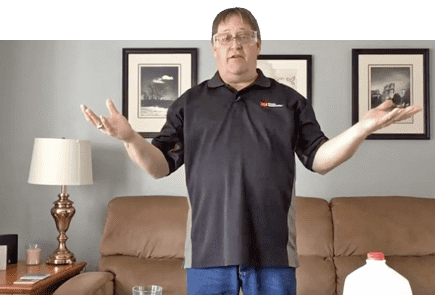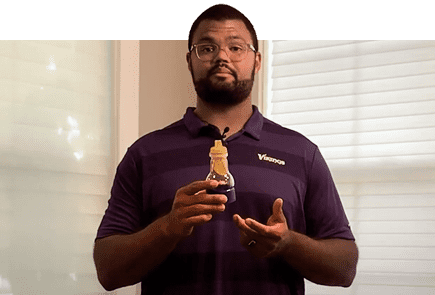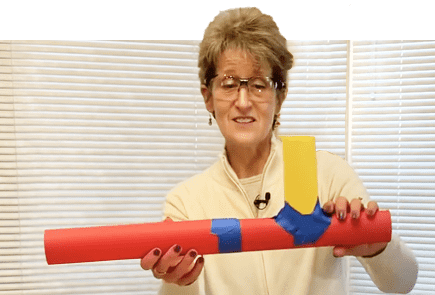Join 3M Researcher Vasav Shani as he introduces you to the science of surface tension. Not only is it only important for many engineering and earth science processes, it also makes blowing bubbles possible.
Background
Much of what we now know about surface tension was discovered by the scientist, Agnes Pockels, who was an early pioneer of "surface science." She did experiments in the sink of her own kitchen and made many important observations that influenced how we study liquids. Surface tension is not only important for many engineering processes - it is also important to the health of the planet, as it allows for the formation of bubbles, which help distribute organic material throughout the layers of the ocean. Today we’re going to do an experiment that will help us better understand how surface tension can be altered with soap and water.
Key Concepts
- Surface Tension
- Forces
Materials
- An adult helper
- Bread clip or notecard cut into a similar shape
- Scissors
- Bowl
- Water
- Liquid soap (dish soap works best)
- Cotton swab or toothpick (optional)
Preparation
- Trim the bread clip into the shape of a boat’s hull - make sure the back of the boat is where the notch in the clip is. You may want an adult to help you with this step. If you don’t have a bread clip, cut out a boat shape (like a pentagon) from a notecard and make a notch in the back of the boat.
- Fill a bowl with water from the tap.
- Make a prediction: What will happen if you put soap into the notch on the back of the boat?
- Place the boat in the water, close to the edge of the bowl
- Use your finger, a toothpick or a cotton swab to dab some dish soap in the notch in the back of the boat. See what happens!
- Don't forget to clean up when you are done. The water can be poured down the drain, and the bowl can be rinsed and put away. You can throw away the boat and cotton swab or toothpicks. Put any other materials back where you found them.
Observation and Results
The boat should zoom forward in the water. This is because liquids always move from low surface tension to high surface tension; this is called the Marangoni effect. Soap has a much lower surface tension than water, so it pushes out from the notch in the back of the boat. This force pushes the boat forward, similar to a rocket pushing fuel out of the tank to propel itself upwards.
This experiment uses a very small boat of a very particular shape. What might happen with a different size or different shape? Can the boat carry any kind of a load? Can you put weight on it and have it still move? How much? Instead of putting weight on the boat, is there a way to turn it into a tug boat, pull something behind it, and still have it work? How does making any of these changes affect the performance of the boat?
Safety First and Adult Supervision
- Follow the experiment’s instructions carefully.
- A responsible adult should assist with each experiment.
- While science experiments at home are exciting ways to learn about science hands-on, please note that some may require participants to take extra safety precautions and/or make a mess.
- Adults should handle or assist with potentially harmful materials or sharp objects.
- Adult should review each experiment and determine what the appropriate age is for the student’s participation in each activity before conducting any experiment.
Next Generation Science Standard (NGSS) Supported - Disciplinary Core Ideas
This experiment was selected for Science at Home because it teaches NGSS Disciplinary Core Ideas, which have broad importance within or across multiple science or engineering disciplines.
Learn more about how this experiment is based in NGSS Disciplinary Core Ideas.
Engineering Design (ETS)1: Engineering Design
Grades K-2
- 2-PS1-1. Different kinds of matter exist and many of them can be either solid or liquid (or gas).
- 2-PS1-2. Different properties are suited to different purposes.
Grades 3-5
- 5-PS1-1. Matter of any type can be subdivided into particles that are too small to see but even then, the matter still exists and can be detected by other means.
- 5-PS1-3. Measurements of a variety of properties can be used to identify materials.
Grades 6-8
- MS-PS1-1. Substances are made of different types of atoms, which combine with one another in various ways. Atoms form molecules that range in size from two to thousands of atoms.
- MS-PS1-4. Gases and liquids are made of molecules or inert atoms that are moving about relative to each other. In a liquid, the molecules are constantly in contact with others.
Grades 9-12
- HS-PS1-1. Each atom has a charged substructure consisting of a nucleus, which is made of protons and neutrons surrounded by electrons.
- HS-PS1-3. The structure and interactions of matter at the bulk scale are determined by electrical forces within and between atoms.
Grades K-2
- K-PS2-1. Pushes and pulls can have different strengths and directions.
- K-PS2-2. Pushing or pulling on an object can change the speed or direction of its motion and can start or stop it.
Grades 3-5
- 3-PS2-1. Each force acts on one particular object and has both strength and a direction.
Grades 6-8
- MS-PS2-1. For any pair of interacting objects, the force exerted by the first object on the second object is equal in strength to the force that the second object exerts on the first, but in the opposite direction.
Grades K-2
- K-PS2-1. When objects touch or collide, they push on one another and can change motion.
Grades 3-5
- 3-PS2-1. Objects in contact exert forces on each other.
Grades 9-12
- HS-PS2-6. Attraction and repulsion between electric charges at the atomic scale explain the structure, properties, and transformations of matter, as well as the contact forces between material objects.
Explore Additional Science at Home Videos and Activities

Liquid Fireworks
Join 3M scientist Jeff Payne as he uses nothing more than milk, dish soap, and a few other kitchen supplies to get the amazing effects of fireworks without using any fire at all.

How Do We Breathe?
How do our lungs work?
Follow along as special guest Dakota Dozier, an offensive lineman for the Minnesota Vikings, makes a model to show how air flows in and out of the lungs with ease.

Bernoulli Balance
A jetliner can weigh over 300 tons, so why doesn’t it just drop out of the air?
3M’s SVP of Corporate Affairs, Denise Rutherford explains the Bernoulli principle and how without it, planes (and birds) couldn’t fly.

